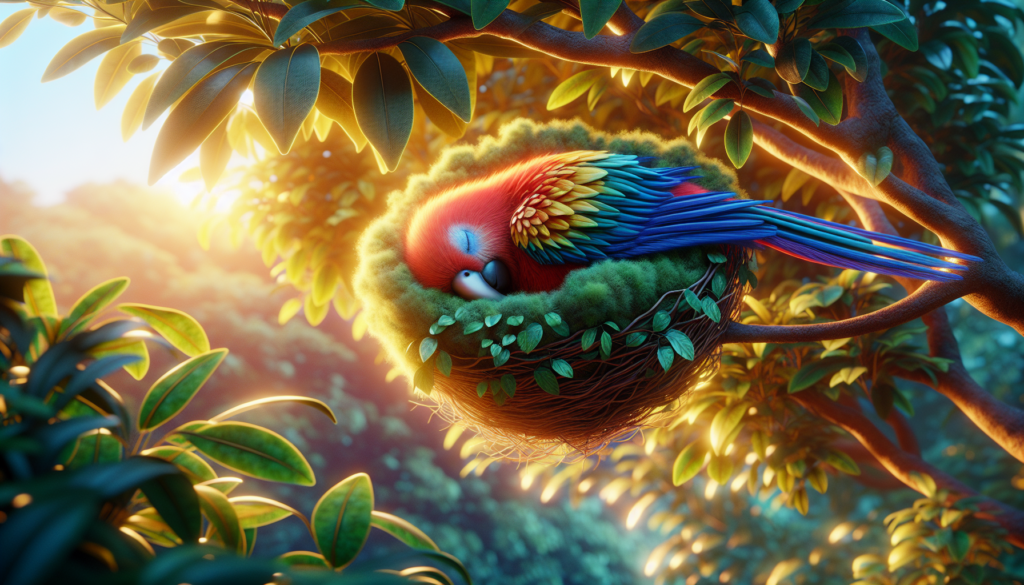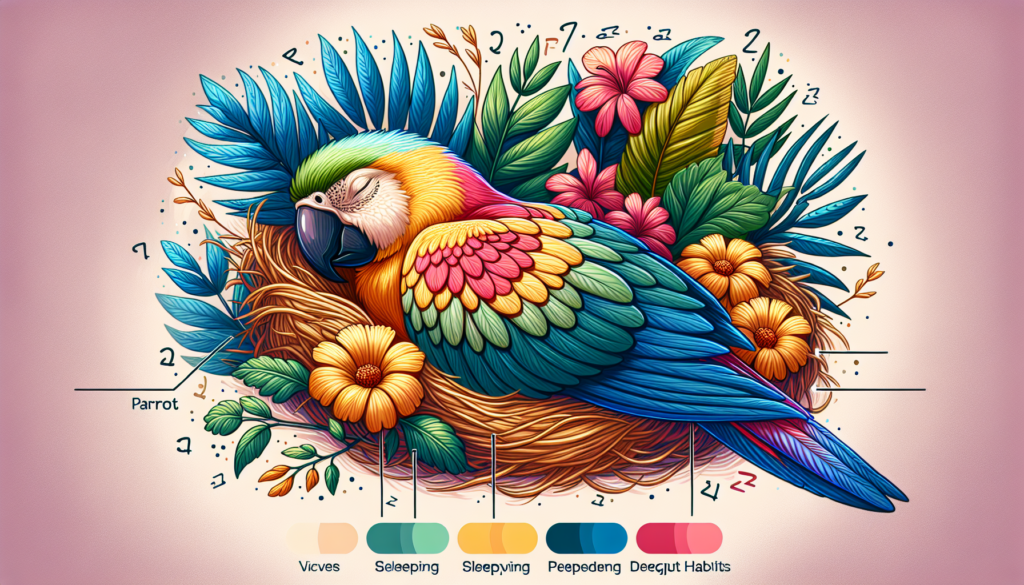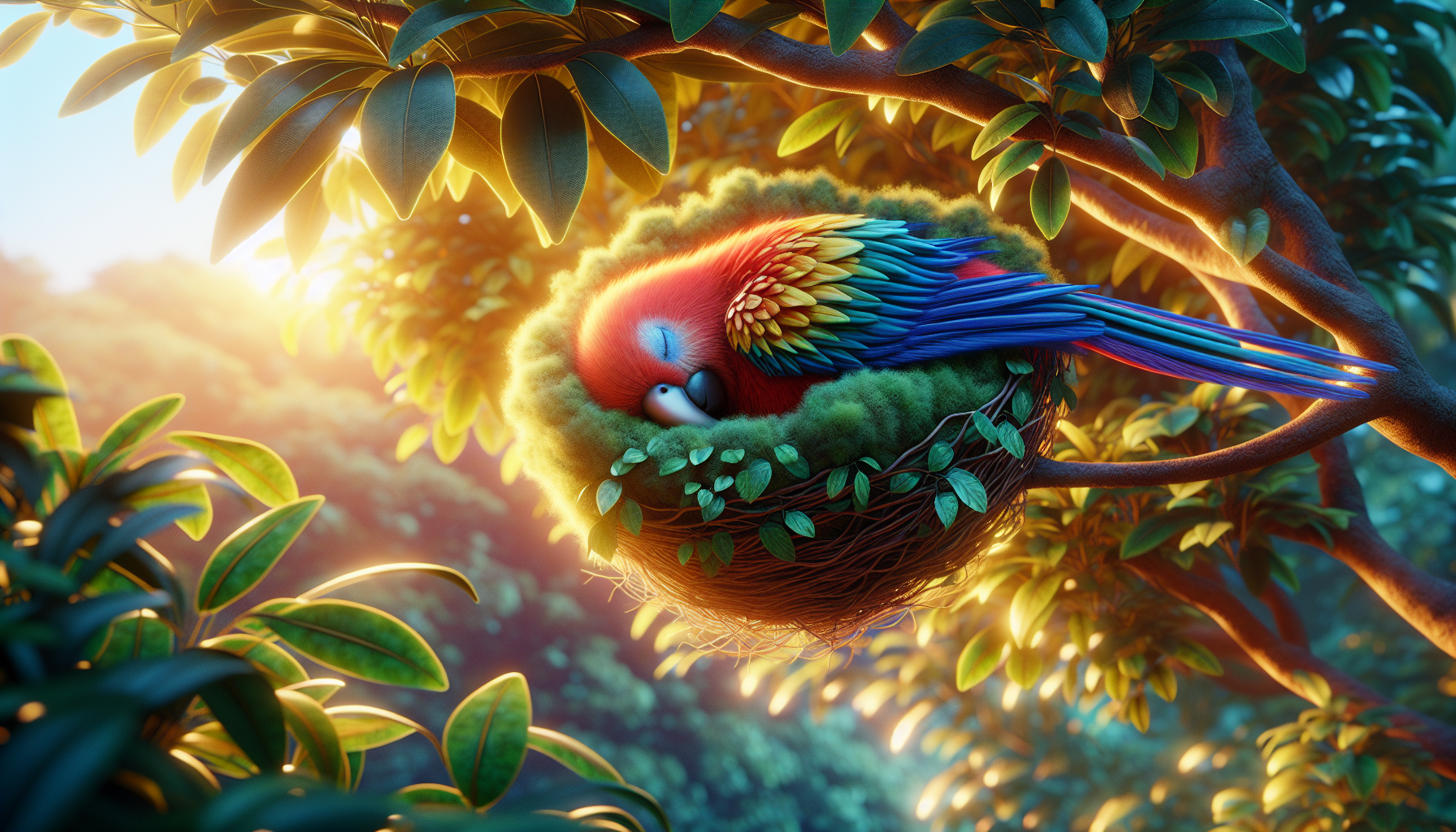Have you ever wondered how parrots sleep? We all know that getting a good night’s sleep is important for our health and well-being, but what about our feathered friends? Parrots have always been fascinating creatures with their vibrant plumage and ability to imitate human speech, but their sleep patterns remain a mystery to many. In this article, we will explore the intriguing world of parrot slumber and uncover the secrets behind their unique sleeping habits. From their ability to sleep with one eye open to their preference for napping at certain times of the day, we will delve into the fascinating realm of understanding the sleep patterns of parrots. So grab a cup of tea and join us on this enlightening journey into the avian sleep world!
Sleep Patterns of Parrots
Parrots are fascinating birds known for their vibrant plumage and intelligent behavior. But have you ever wondered how these feathered creatures sleep? Understanding the sleep patterns of parrots is essential for their overall well-being and care. In this article, we will delve into various aspects of their sleep, including sleep duration, sleeping positions, light and dark preferences, sleep-related behaviors, sleep cycles, sleep deprivation, environmental factors, and how their sleeping patterns differ in the wild compared to captivity.
Sleep Duration
Just like humans, parrots require adequate sleep to maintain good health. On average, parrots sleep for around 10 to 12 hours every night. However, the exact duration may vary depending on the species, age, and individual bird. Some parrots may need slightly more or less sleep than others. It’s important to note that parrots are diurnal creatures, meaning they are most active during the day and sleep primarily during the night.
Napping Habits
In addition to their nightly sleep, parrots also take short naps throughout the day. These naps usually last for about 15 to 20 minutes and serve as a way for them to recharge and rest. It is common to see parrots dozing off during the midday or after a particularly stimulating activity. These quick naps help them maintain their energy levels and alertness.

Sleeping Positions
Parrots exhibit various sleeping positions while they rest. One common position is tucking their head under their feathers and standing on one leg. This posture helps them conserve body heat and maintain balance while sleeping. Some parrots may also sleep upright, with their head resting on their back or tucking their beak into their feathers. It is important to provide your pet parrot with a comfortable sleeping perch that allows them to assume their preferred sleeping position easily.
Playful Sleeping Habits
Interestingly, parrots have been observed engaging in playful sleeping habits, such as hanging upside down while sleeping or sleeping while perched on their back. These behaviors not only showcase the dexterity and flexibility of these birds but also highlight their unique personalities and adaptability.
Light and Dark Preferences
While parrots sleep primarily during the night, their sleep patterns can be influenced by light and darkness. In the wild, parrots are attuned to the natural light cycle, and as the sun sets, they prepare for sleep. In captivity, it is important to create a sleep environment that mimics these lighting conditions. Providing a quiet, dimly lit space during the night will help regulate their sleep-wake cycle and ensure they receive the rest they need.
Impact of Artificial Lighting
Exposure to artificial lighting, especially during the late hours, can disrupt the sleep patterns of parrots. Excessive exposure to bright lights or prolonged exposure to screens can lead to sleep disturbances and restlessness. It is crucial to minimize exposure to artificial light sources in the evening to maintain a healthy sleep routine for your feathered companion.

Sleep Related Behaviors
Parrots exhibit interesting sleep-related behaviors that contribute to their well-being. Pre-sleep rituals, such as feather preening and body stretching, are commonly observed before they settle down for the night. These activities help them relax and prepare for sleep. Additionally, parrots may engage in vocalizations or talking before falling asleep, sometimes mimicking sounds they have heard during the day, demonstrating their ability to process and replay information during their sleep stages.
Night Frights
Night frights can occur in parrots, especially when they experience sudden loud noises or visual disturbances during their sleep. These episodes can cause distress and panic, leading to injury or feather plucking. To prevent night frights, it is vital to create a calm and quiet sleeping environment, shielding them from sudden disruptions that could startle them awake.
Sleep Cycles
Similar to humans, parrots go through different stages of sleep in a cyclical manner. These stages include slow-wave sleep (SWS) and rapid eye movement (REM) sleep. SWS is characterized by deep sleep, where bodily functions slow down, and brain waves become more synchronized. REM sleep, on the other hand, is associated with dreaming, muscle relaxation, and heightened brain activity. Parrots experience both SWS and REM sleep during their nightly rest.
Dreaming in Parrots
Research suggests that parrots indeed experience dreams during their REM sleep. This fascinating discovery showcases the incredible cognitive abilities of these birds, as they can process emotions and memories even during their sleep. Observing their subtle body movements and vocalizations during REM sleep can provide insights into their dream experiences.
Sleep Deprivation
Just like any other living creature, parrots can suffer from the negative effects of sleep deprivation. Lack of sufficient sleep can result in various issues, including irritability, increased stress levels, weakened immune system, poor concentration, and decreased cognitive function. It is crucial to ensure that your parrot receives adequate sleep every night to maintain their overall health and well-being.
Signs of Sleep Deprivation
If your parrot is not getting enough sleep, you may notice signs of sleep deprivation, such as excessive tiredness, increased aggression or irritability, reduced appetite, disheveled feathers, and decreased activity levels. If you observe these signs, it is important to provide a suitable sleep environment and consult with an avian veterinarian to address any underlying issues that may be interfering with their sleep.
Environmental Factors and Sleep
Creating an optimal sleep environment for your parrot is essential to promote good quality sleep. Temperature, noise levels, and air circulation can significantly impact their sleep patterns. Parrots prefer slightly cooler temperatures during sleep, around 65 to 75 degrees Fahrenheit (18 to 24 degrees Celsius). Providing a quiet space, away from loud noises and disturbances, allows them to sleep peacefully. Additionally, ensuring proper air circulation is essential to maintain fresh air and prevent stuffiness.
Sleep Hygiene
Maintaining good sleep hygiene for your parrot involves keeping their sleeping area clean and comfortable. Regularly inspecting their sleeping perch, cage, and bedding for any signs of dirt or debris is essential. Ensure that the bedding is dry and free from any harmful substances or irritants that could affect their respiratory health. Adhering to good sleep hygiene practices helps create a safe and hygienic sleep environment for your feathered friend.
Sleeping Patterns in the Wild
In the wild, the sleep patterns of parrots are influenced by various factors, such as food availability, predators, and social dynamics. Their ability to sleep perched high in trees and their unique sleeping positions allows them to blend into their surroundings and avoid detection by potential predators. Additionally, the natural light-dark cycle guides their sleep-wake patterns, ensuring they are active during times of optimal foraging and resting during the night.
Flock Sleep Patterns
Parrots are social creatures and often sleep in groups, known as flocks, which provides them added protection and a sense of security. This communal sleeping arrangement allows them to take turns being on guard while others sleep, ensuring the safety of the flock as a whole. The synchronized sleeping patterns of the flock not only provide security but also reinforce social bonds within the group.
Sleeping Patterns in Captivity
Sleep patterns in captivity may differ from those observed in the wild due to environmental differences and lack of natural cues. Parrots in captivity often rely on their caretakers to establish a consistent sleep routine and create a sleep-friendly environment. Providing a quiet, darkened space for sleep, incorporating pre-sleep rituals, and maintaining a predictable daily schedule can help simulate natural sleep patterns and ensure that captive parrots receive the rest they need.
In conclusion, understanding the sleep patterns of parrots is crucial for their physical and mental well-being. By acknowledging their sleep duration, sleeping positions, light and dark preferences, sleep-related behaviors, sleep cycles, and environmental factors, we can create a comfortable sleep environment that helps foster a healthy and restful sleep for these captivating creatures. Whether in the wild or in captivity, ensuring that parrots get sufficient sleep is key to their happiness and overall quality of life.
